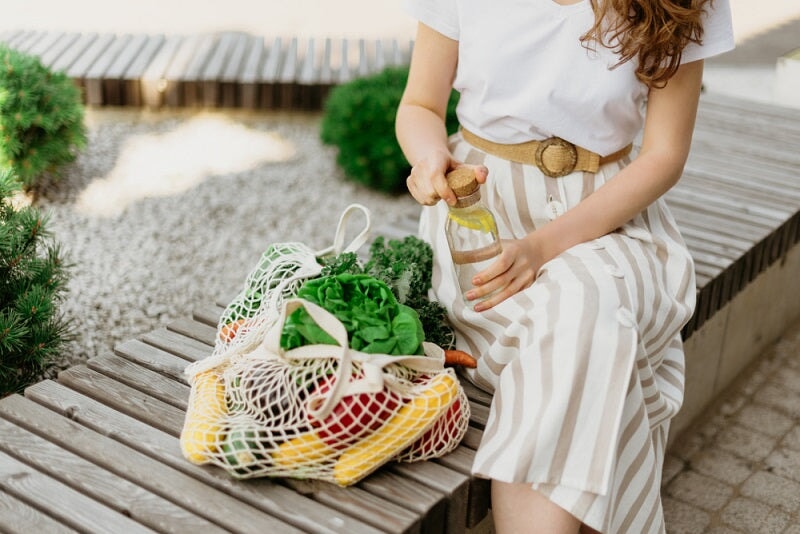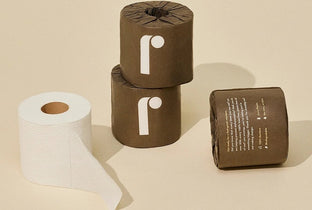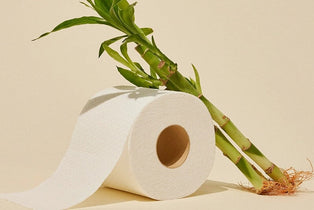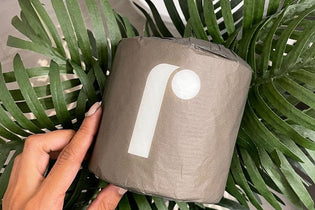
TLDR
Plastic pollution is an ever-increasing environmental concern. Plastic clings to our every day, from our food packaging to personal care products, and it's taking a toll on the environment. But we can all help the earth by learning how to reduce plastic use.
And the truth is, it's pretty straightforward. There are some simple ways to reduce plastic waste and make a big difference in your home.
This article will share four easy and effective strategies to reduce household plastic waste. Regardless of budget or lifestyle, these are simple changes anyone can make. We'll cover topics such as reducing single-use plastics, choosing plastic product alternatives, and how to dispose of plastic goods properly.
Each year, tons of plastic end up in our oceans, harming wildlife and damaging fragile ecosystems—73 million metric tons in 2019, to be exact.1 That’s why we’ve included some practical tips and tricks on how to reduce plastic use in your household and everyday lifestyle.

#1 Use Reusable Shopping Bags
Using reusable shopping bags are one of the easiest and most effective ways to reduce plastic waste from your household. It’s a small but essential step that can make a big difference for the environment. Plastic bags are among some of the top products for plastic waste, with roughly 500 billion plastic bags being used worldwide each year, while the U.S. is responsible for one-fifth of that amount. Yes, the U.S. alone uses 100 billion plastic bags annually!2
And it’s not just beneficial to cut out plastic bags. Adding reusable bags to your lifestyle also comes with its own perks. Let’s look at a few benefits of reusable shopping bags:
- Environmental benefits – Reusable shopping bags can limit the quantity of plastic waste in waterways, oceans, and landfills. This also helps protect the health of sea and land creatures. Not only are plastic bags challenging to recycle, but they’re also costly. Most of them end up in landfills, taking upwards of 300 years to photodegrade.2
- Convenience – More often than not, reusable bags can hold more groceries than standard plastic bags. Certain varieties, like cloth or canvas, come with comfier and easy-to-hold straps, making carrying your groceries to the car and house easier.
- Versatility – You can use your reusable grocery bags to carry much more than groceries, such as books, gym clothes, or other everyday items, making them a versatile and practical investment. Plus, you don’t have to worry about them tearing as easily or nearly as much as plastic bags.
- Cost savings – If the other benefits haven’t sold you yet, maybe a few extra bucks in your pocket will. Sure, they may cost a couple of dollars upfront. But in the long run, many big and small chain grocers reward shoppers who toss the plastic product for more sustainable shopping practices by offering incentives and cashback rewards.
#2 Refuse Single-Use Plastics
In addition to opting for reusable bags, refusing single-use plastics, in general, can be another impactful approach. Food and beverage packaging is one of the leading household plastic waste categories, accounting for roughly 31.14% of all plastic waste.3
It can be as simple as saying no to plastic straws or carrying a reusable water bottle. These small swaps can go a long way in creating awareness and setting examples for people and companies unaware of plastic's devastating environmental impact.
Here are some ways to avoid single-use plastics:
Use a Refillable Water Bottle
You can carry a reusable water bottle instead of buying single-use plastic bottles. Fill it up before you leave the house or at water fountains or refilling stations, which are becoming increasingly available.
Avoid Plastic Straws
When dining out, ask for drinks without straws. Or, if you’re not one for drinking from the glass, consider bringing your own straw made from more sustainable materials such as metal, bamboo, or silicone. If ordering take-out, request that plastic straws, utensils, and condiment packets not be included.
Carry a Reusable Coffee Cup
If you don’t have the time to make coffee at home before heading to work, bring a reusable coffee cup when buying coffee on the go instead of using disposable coffee cups with plastic lids.
Buy Plastic-Free Grocery Products
Whether shopping for groceries or personal care products, toys, or other goods, choose products packaged in glass, cardboard, or metal instead of plastic. Also, buy food and beverage items in bulk or reusable containers instead of the kinds wrapped in plastic.
#3 Recycle Plastic Properly
Recycling plastic waste is vital to promoting a more sustainable future. Taking the extra step to follow local recycling guidelines, instead of guessing or throwing plastic in the trash, gives plastic another life outside of landfills.
Unfortunately, in 2018, more than 35 million tons of plastics were created, but only 8.7% of that was recycled.4
So here are some tips on how to recycle plastics properly:
- Check local recycling guidelines – Check with your local recycling program to find out what types of plastics are accepted in your area. These guidelines can vary depending on your location.
- Know what types of plastics are recyclable – Most curbside programs accept plastics labeled with a recycling symbol and a number 1 through 7. That said, some types of plastic, such as polystyrene foam and PVC, are not recyclable in most curbside programs.4 So if you find products with these kinds of plastics, try to swap them for other alternatives.
- Flatten items – Flattening plastic containers and bottles may seem like an odd tip, but it will save space and make transporting the items to the facility easier. In the end, saving space means fewer trips and fewer fossil fuels burned in the process.
- Clean and dry plastic items – Remember to rinse plastic containers and bottles to remove any food residue, and let them dry before tossing them into the recycling bin. They don’t have to be squeaky clean, but a good rinse will go a long way and ensure it's bound for a new life instead of the landfill.
If you have any compostable packaging or products, it’s important to note that they are not intended for recycling and should not be mixed with recyclable plastics. If you don’t have the means of composting in your home, check with your local municipalities for nearby drop-offs.
#4 Avoid Microplastic Beads in Home & Personal Care Products
Microplastics beads are tiny pieces of plastic less than 5 millimeters long which can be found in various products, including but not limited to:6
- Cosmetics
- Personal care products
Microplastics beads are a growing environmental concern because they can be ingested by animals and humans with potential long-term health effects. They also sneak their way into our waterways, cycling into groundwater that feeds plants and into our food chain.
Sadly, microplastics beads are becoming more prevalent today as well. Not only should you avoid consuming or using products with microplastic beads as much as possible, but you can also do your part to boycott products that exacerbate the problem to slow the prevalence of microplastic beads.
So here are some tips for avoiding microplastic bead consumption
- Use natural or organic products – Buy products free of microbeads and other synthetic materials.
- Check the label – Familiarize yourself with ingredients, so that you can easily tell which products should be avoided.
- Make your own products – The best way to know exactly what is in your cosmetics is if you make them yourself. Body scrubs, which often have microplastic beads, are one of the easiest products to make at home - you just need sugar or salt and oil.
By following these tips, you can help reduce the number of microplastics that enter the environment while also protecting the health of our planet.
How to Assess Your Household Plastic Waste
In 2021, Americans threw out 51 million tons of bottles, wrappers, and bags, which breaks down to roughly 309 pounds of plastic per person. The even more jarring statistic is that approximately 95% of that went into landfills and oceans.7 So if you’re wondering how to reduce household plastic waste, let's begin by examining how you can assess your own household plastic waste production.
Take a week, be conscious, and observe all the plastic waste you generate. Begin by separating it from other types of waste and categorizing it. For example, isolate plastic bottles from plastic bags and food packaging from other plastic items. After the assessment, take stock of the waste you’d normally generate. Doing so will give you a better idea of your plastic consumption habits.
Next, identify areas where you can make more sustainable choices. It may also be helpful to start with one area of your household at a time—bathroom products first, kitchen products second, and so on. Set goals in a place where they’ll be visible on a daily basis and track your progress.
Reel Paper: Making Your First Household Swap Easy
With the dangers and toxins plastic reaps on the environment, it’s paramount that we do our part to start reducing, or ideally, replacing, plastic with sustainable alternatives. Plastic bags, which are only used for 12 minutes each on average, are thrown in the garbage, where they will take 1,000 years to degrade while spreading microplastics into the surrounding environment.8
We have the power to rewrite that story. There’s a story of sustainable, earth-loving products. And that story starts with sustainable, biodegradable, and plastic-free packaging.
At Reel Paper, we set out to reimagine household products that normally generate plastic waste in an earth-conscious way. Instead of toilet paper, paper towels, and tissues with single-use paper and plastic packaging, we offer sustainable paper products wrapped with zero plastic packaging, from recycled paper towels to bamboo toilet paper.
Nothing extra, just extra-good paper products. A responsibly sourced product with easily recyclable or compostable packaging, a premium product made without harsh chemicals, and free shipping for bulk toilet paper orders and other products to boot. Your first household plastic swap is here knocking at your door. Find our bamboo toilet paper in a store near you.
Sources:
- Statistica. Plastic waste in the United States - statistics & facts. https://www.statista.com/topics/5127/plastic-waste-in-the-united-states/
- County of Los Angeles. Plastic Bag Pollution. https://dpw.lacounty.gov/epd/plasticbags/articles/googobits_07-21-05.pdf
- rePurpose. Which Plastics are the Major Contributors to Plastic Pollution? https://repurpose.global/blog/post/major-contributors-to-plastic-pollution
- EPA. Plastics. https://www.epa.gov/recycle/how-do-i-recycle-common-recyclables#pla
- Bon Appétit. How Much Microplastics Am I Eating? And Is There Any Way To Avoid It? https://www.bonappetit.com/story/microplastics-food
- NOAA. What are Microplastics? https://oceanservice.noaa.gov/facts/microplastics.html
- The Guardian. Only 5% of plastic waste generated by US last year was recycled. https://www.theguardian.com/us-news/2022/oct/23/us-plastic-waste-recycled-2021-greenpeace
- Center for Biological Diversity. !0 Facts About Single-Use Plastic. https://www.biologicaldiversity.org/programs/population_and_sustainability/sustainability/plastic_bag_facts.html




0 comments